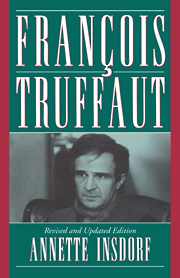Book contents
Preface
Summary
THIS BOOK GROWS out of my deep affection and respect for the films of François Truffaut. It is from my teaching of “The French New Wave” and other courses in cinema at Yale that the study developed, and I see my role before the reader as continuous with my function before a class: to communicate and justify through close analysis my enthusiasm for the aesthetic and experiential richness of the subject. I address primarily those who are already aware of Truffaut's talent and achievement and wish to explore the thematic and stylistic concerns that have emerged from his films. I hope this approach results in the tone of sympathy that characterizes Truffaut's attitude toward his medium, his mentors, his material, and his performers.
Truffaut's films constitute what he once termed “cinema in the first person singular,” and I have therefore tried to retain the personal context, effect, and purpose of his efforts. The first chapter serves as an introduction to the French New Wave and Truffaut's transition from critic to director. After connecting three “Charlie” characters who are central to this movement in film history — Chaplin, Orson Welles' Charlie (Citizen) Kane, and Charlie Kohler of Shoot the Piano Player — I move in Chapters 2 and 3 to Truffaut's relationship to his mentors, Alfred Hitchcock and Jean Renoir.
- Type
- Chapter
- Information
- François Truffaut , pp. 9 - 10Publisher: Cambridge University PressPrint publication year: 1995



